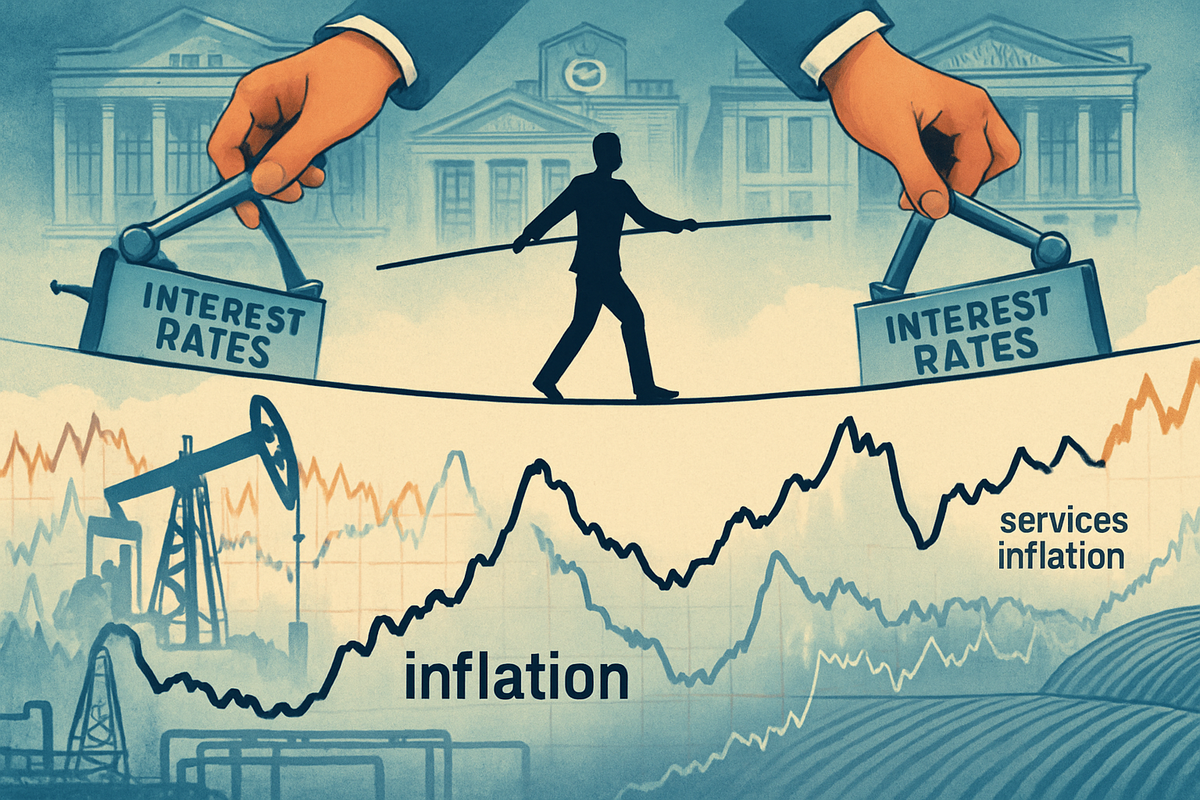Financial News
Navigating the Disinflationary Tightrope: How Commodity Swings and Central Bank Cuts are Reshaping the Global Economic Outlook

Global financial markets are currently grappling with the complex interplay of moderating inflation, volatile commodity prices, and evolving central bank monetary policies. As of October 7, 2025, the world economy is charting a course through a period of cautious optimism, where the aggressive rate hikes of previous years have given way to a more nuanced approach of rate cuts and strategic pauses by major central banks. This shift, largely influenced by a gradual easing of headline inflation and mixed signals from energy and food markets, carries significant implications for investors, businesses, and consumers alike.
The trajectory of inflation, while generally declining, remains a focal point, with services inflation proving stubbornly persistent in some advanced economies. Commodity prices, particularly oil and natural gas, have shown a tendency towards stabilization or even decline in certain forecasts for late 2025 and 2026, yet short-term volatility, as seen with natural gas rebounds and continued food price increases, continues to pose challenges. Central banks, including the U.S. Federal Reserve, the European Central Bank, and the Bank of England, have each embarked on distinct paths of monetary easing, carefully balancing the need to tame inflation against the imperative to support economic growth, setting the stage for critical decisions in the coming months.
Central Banks Pivot Amidst Easing, Yet Persistent, Inflation
The global economic landscape in late 2024 and through 2025 has been defined by a gradual, albeit uneven, descent in headline inflation from its multi-decade highs. This disinflationary trend has allowed major central banks to begin pivoting from aggressive tightening cycles to more accommodative stances. However, the path has been anything but straightforward, marked by stubborn services inflation and renewed volatility in key commodity markets.
The U.S. Federal Reserve (FED) initiated its easing cycle in September 2024, cutting the federal funds rate by 50 basis points to a range of 4.75% to 5.00%. This was followed by two more 25 basis point reductions in the subsequent months, settling at 4.25% to 4.50% by December 2024. The Fed maintained this target through the first half of 2025, signaling a cautious approach. However, in September 2025, in what Chair Jerome Powell characterized as a "risk management cut," the Fed further reduced rates by 25 basis points to a range of 4.00%–4.25%. This move comes ahead of the next scheduled decision on October 29, 2025, with market participants closely watching for further signals of easing, as J.P. Morgan Global Research anticipates two more Fed cuts in 2025.
Across the Atlantic, the European Central Bank (ECB) began its rate-cutting journey in June 2024, marking a significant shift in its monetary policy. The ECB continued with several reductions through early 2025, including a 25 basis point cut in June 2025, lowering the deposit facility rate to 2.00%. After 200 basis points of cuts between June 2024 and June 2025, the ECB paused its easing cycle in July and September 2025, holding rates steady. The ECB's September 2025 staff projections foresee headline inflation averaging 2.1% in 2025, nearing its 2% target. The next ECB interest rate decision is slated for October 30, 2025.
Similarly, the Bank of England (BoE) adopted a "gradual and careful" strategy. The BoE initiated cuts in August and November 2024, bringing the base rate down to 4.75%, and continued with further reductions in February and May 2025, reaching 4.25%. On August 7, 2025, the Monetary Policy Committee (MPC) voted to cut the base rate to 4.0%. However, mirroring the ECB's recent caution, the BoE held rates unchanged at 4.0% in September 2025, despite a split vote. This pause reflects concerns about persistent inflation, with the BoE expecting inflation to rise to 4.0% in September 2025 before eventually returning to its 2% target by Q2 2027. The next BoE decision is scheduled for November 6, 2025.
The uneven pace of disinflation, particularly the stickiness of services inflation and the mixed signals from commodity markets, has complicated these central bank decisions. While oil prices are generally projected to decline or stabilize in late 2025 and early 2026 due to oversupply, natural gas prices saw a significant rebound in early 2025 due to colder temperatures and increased demand. Food price inflation has also remained a concern, consistently outpacing overall inflation since 2020, with the UN Food and Agriculture Organization (FAO) highlighting a "perfect storm" of crises contributing to surges between 2020 and 2024.
Corporate Winners and Losers in a Shifting Economic Tide
The current economic environment, characterized by moderating but persistent inflation, fluctuating commodity prices, and central banks carefully navigating interest rate adjustments, creates a distinct landscape of winners and losers across various industries. Companies with strong pricing power and those less reliant on volatile input costs are likely to thrive, while others may face significant headwinds.
Commodity producers, particularly those in the energy sector like ExxonMobil (NYSE: XOM) and Chevron (NYSE: CVX), could see mixed fortunes. While forecasts suggest a general decline or stabilization in oil prices for late 2025 and early 2026 due to oversupply, short-term volatility and geopolitical factors can still lead to price spikes, boosting their revenues. However, a sustained downward trend in oil prices could pressure their profitability. Similarly, natural gas producers like EQT Corporation (NYSE: EQT) benefited from the early 2025 rebound in gas prices but remain susceptible to future price declines driven by increased production outpacing demand, as projected by the EIA for inflation-adjusted prices in 2025.
On the other hand, companies heavily reliant on commodity inputs stand to benefit from easing commodity prices. Airlines such as Delta Air Lines (NYSE: DAL) and Southwest Airlines (NYSE: LUV) will see reduced fuel costs, directly impacting their operational expenses and potentially boosting profit margins. Similarly, transportation and logistics firms like FedEx (NYSE: FDX) and UPS (NYSE: UPS) could experience relief from lower fuel prices, improving their bottom lines. Manufacturing companies that use significant raw materials, from plastics to metals, may also see their input costs stabilize or decrease, enhancing profitability.
The cautious approach to interest rate cuts by central banks also has significant implications. Financial institutions, particularly banks like JPMorgan Chase (NYSE: JPM) and Bank of America (NYSE: BAC), typically benefit from higher interest rate environments as it increases their net interest margins (the difference between what they earn on loans and pay on deposits). A prolonged period of rate cuts, while stimulating borrowing, could compress these margins. However, increased lending activity driven by lower rates could partially offset this. Conversely, companies with high levels of debt or those in capital-intensive industries such as utilities like NextEra Energy (NYSE: NEE) or real estate developers like Prologis (NYSE: PLD) will benefit from lower borrowing costs, making expansion and refinancing more affordable.
Finally, consumer discretionary companies like Amazon (NASDAQ: AMZN) or Starbucks (NASDAQ: SBUX) could see a boost from an easing inflationary environment and lower interest rates, as consumers' purchasing power improves and borrowing for larger purchases becomes more attractive. However, consumer staples companies like Procter & Gamble (NYSE: PG) and Nestlé (SIX: NESN), which have benefited from their pricing power during high inflation, might face challenges if consumers become more price-sensitive in a disinflationary environment, although their essential nature provides some resilience.
Broader Implications and Historical Parallels
The current economic juncture, marked by central bank pivots and oscillating commodity markets, carries profound wider significance, shaping global trade, investment flows, and regulatory landscapes. This period fits into broader industry trends of supply chain recalibration, energy transition complexities, and the ongoing debate over the efficacy of monetary policy in managing modern inflationary pressures.
The cautious and differentiated approach by major central banks highlights a global divergence in economic conditions and inflationary drivers. While the Federal Reserve, ECB, and Bank of England have all embarked on easing cycles, the pace and conviction vary, reflecting distinct domestic inflation profiles, labor market strengths, and fiscal policy backdrops. This divergence can lead to currency volatility, impacting the competitiveness of export-oriented industries and the cost of imports for various nations. For instance, a stronger U.S. dollar, if the Fed cuts rates less aggressively than its counterparts, could make American exports more expensive.
The volatility in commodity prices, particularly energy and food, continues to underscore the fragility of global supply chains and the impact of geopolitical events. The sharp rebound in natural gas prices in early 2025, despite projections of overall decline, serves as a stark reminder of the energy market's susceptibility to demand shocks and weather patterns. Similarly, persistent food price inflation, highlighted by the FAO's "perfect storm" report, points to systemic issues beyond monetary policy, including climate change, conflict, and agricultural trade policies. This reinforces the need for greater energy security and food system resilience, potentially spurring increased investment in renewable energy technologies and diversified agricultural practices.
From a regulatory and policy perspective, the prolonged battle against inflation has reignited discussions about central bank mandates and tools. The stickiness of services inflation, for example, suggests that demand-side measures (interest rates) alone may be insufficient to address all inflationary pressures, potentially requiring complementary fiscal policies or structural reforms. Furthermore, the use of "risk management cuts" by the Fed, as described by Chair Powell in September 2025, indicates a proactive stance to prevent economic downturns, rather than solely reacting to inflation data. This could set a precedent for future central bank interventions, balancing inflation control with growth support.
Historically, periods of fluctuating commodity prices and central bank policy shifts have often been precursors to significant economic realignments. The oil shocks of the 1970s, for instance, led to a decade of stagflation and fundamental changes in energy policy. More recently, the post-2008 era saw unconventional monetary policies become the norm. The current situation, while not directly analogous, shares elements of both – the commodity-driven inflation of the 70s and the central bank innovation of the 2010s. The challenge now is to navigate disinflation without triggering a recession, a tightrope walk that requires precise and timely policy adjustments, learning from past successes and failures in managing economic transitions.
The Road Ahead: Navigating Uncertainty and Opportunity
Looking ahead, the global financial markets face a dynamic and uncertain path, influenced by the continued evolution of inflation, commodity price movements, and central bank policy responses. The short-term will likely be characterized by continued market sensitivity to economic data releases, particularly inflation reports and central bank statements, while the long-term outlook will hinge on the successful navigation of disinflationary pressures without stifling economic growth.
In the short term, the upcoming central bank meetings – the Federal Reserve on October 29, the ECB on October 30, and the Bank of England on November 6, 2025 – will be pivotal. Any deviation from market expectations regarding rate cuts or holds could trigger significant market reactions. Investors will be closely watching for forward guidance on the future trajectory of interest rates, particularly how central banks weigh persistent services inflation against moderating headline figures and the resilience of labor markets. Furthermore, continued monitoring of key commodity prices, especially oil and natural gas, will be crucial, as unexpected supply disruptions or demand surges could quickly alter the inflation outlook.
Potential strategic pivots for businesses will involve adapting to a potentially lower, but still volatile, interest rate environment. Companies with high debt loads may consider refinancing to lock in lower rates, while those in growth sectors might find capital more accessible for expansion. Supply chain resilience will remain a critical focus, with businesses seeking to diversify sourcing and mitigate the impact of commodity price shocks. The emphasis on efficiency and cost control, honed during the recent inflationary period, will likely continue, even as input costs potentially ease.
Market opportunities may emerge in sectors that benefit from lower borrowing costs and increased consumer spending power, such as technology, consumer discretionary, and certain segments of real estate. Companies offering innovative solutions for energy efficiency or sustainable agriculture could also see increased investment, driven by the broader recognition of commodity market vulnerabilities. Conversely, challenges may persist for industries with significant exposure to volatile energy costs or those facing intense competition in a disinflationary environment where pricing power diminishes.
Several potential scenarios could unfold. In an optimistic scenario, central banks successfully engineer a "soft landing," achieving their inflation targets while maintaining robust economic growth, leading to a sustained period of lower interest rates and stable commodity markets. A more challenging scenario involves a resurgence of inflation, perhaps due to unexpected commodity shocks or persistent wage pressures, forcing central banks to reverse course and resume tightening, potentially leading to an economic slowdown. Another possibility is a prolonged period of modest growth with stubbornly sticky inflation, requiring central banks to maintain a cautious, data-dependent stance for an extended period.
Wrap-Up: A Delicate Balance for Global Markets
The current financial landscape is defined by a delicate balance, where the forces of disinflation are gradually taking hold, but not without significant caveats. Central banks worldwide have moved decisively from aggressive tightening to a more nuanced approach of interest rate cuts and strategic pauses, reflecting a careful calibration between taming inflation and supporting economic activity. The key takeaway is that while headline inflation is moderating, underlying pressures, particularly from services and certain commodity markets, continue to demand vigilance.
Moving forward, the market will remain highly sensitive to incoming economic data, especially inflation metrics, labor market reports, and central bank communications. The upcoming interest rate decisions from the Federal Reserve, ECB, and Bank of England in late October and early November 2025 will provide critical insights into their respective policy trajectories and their assessments of the global economic outlook. Investors should be prepared for continued volatility, as the interplay between monetary policy, commodity prices, and geopolitical events shapes market sentiment.
The lasting impact of this period will likely be a renewed focus on supply chain resilience, energy independence, and the limits of monetary policy in addressing all forms of inflation. Businesses that can adapt quickly to changing cost structures and consumer behaviors will be best positioned to thrive. Investors should watch for signs of sustained disinflation, the pace and number of future rate cuts, and any significant shifts in commodity market dynamics. Diversification and a long-term perspective will be crucial in navigating these complex and evolving financial markets.
This content is intended for informational purposes only and is not financial advice
More News
View More




Recent Quotes
View More
Quotes delayed at least 20 minutes.
By accessing this page, you agree to the Privacy Policy and Terms Of Service.



